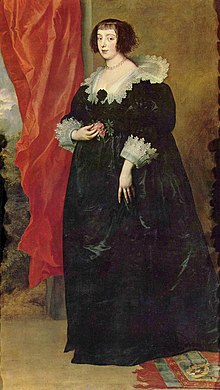Marguerite of Lorraine
| Marguerite of Lorraine | |
|---|---|
| Duchess of Orléans | |

Portrait by van Dyck
|
|
| Born |
22 July 1615 Ducal Palace, Nancy, Lorraine |
| Died | 13 April 1672 (aged 56) Palais d'Orléans, Paris, France |
| Burial | Basilica of Saint-Denis |
| Spouse | Gaston, Duke of Orléans |
| Issue |
Marguerite Louise, Grand Duchess of Tuscany; Isabelle, Duchess of Guise Françoise Madeleine, Duchess of Savoy Jean Gaston, Duke of Valois Marie Anne, Mademoiselle de Chartres |
| House | House of Lorraine |
| Father | Francis II, Duke of Lorraine |
| Mother | Countess Christina of Salm |
| Religion | Roman Catholicism |
| Signature | |
Marguerite of Lorraine (22 July 1615 – 13 April 1672), Duchess of Orléans, was the wife of Gaston, younger brother of Louis XIII of France. As Gaston had married her in secret in defiance of the King, Louis had their marriage nullified when it became known. On his deathbed, Louis permitted them to marry. After their remarriage, Marguerite and Gaston had five children. She was the stepmother of La Grande Mademoiselle.
She was born in Nancy, Lorraine to Francis II, Duke of Lorraine, and Countess Christina of Salm. One of six children, she grew up in Nancy which was the capital of her father's duchy. After losing her mother in 1627, she was brought up by her aunt Catherine of Lorraine—the Abbess of Remiremont. Two of her older brothers, Charles and Nicolas, were successively dukes of Lorraine.
While taking refuge from the wrath of the French prime minister, Cardinal Richelieu, Gaston, Duke of Orléans, younger brother and heir presumptive of Louis XIII of France, fell in love at first sight with Marguerite. But as France and Lorraine were then enemies, he was refused the king's permission to marry with a sister of its duke, Charles III. Nonetheless Gaston fled again to Lorraine and, in a secret ceremony in the presence of her family at Nancy during the night of 2–3 January 1632, Gaston took the princess Marguerite as his wife. Because he had not obtained the prior permission of his elder brother—one of his many acts of defiance—the couple could not appear at the French court and the marriage was kept secret.
...
Wikipedia
